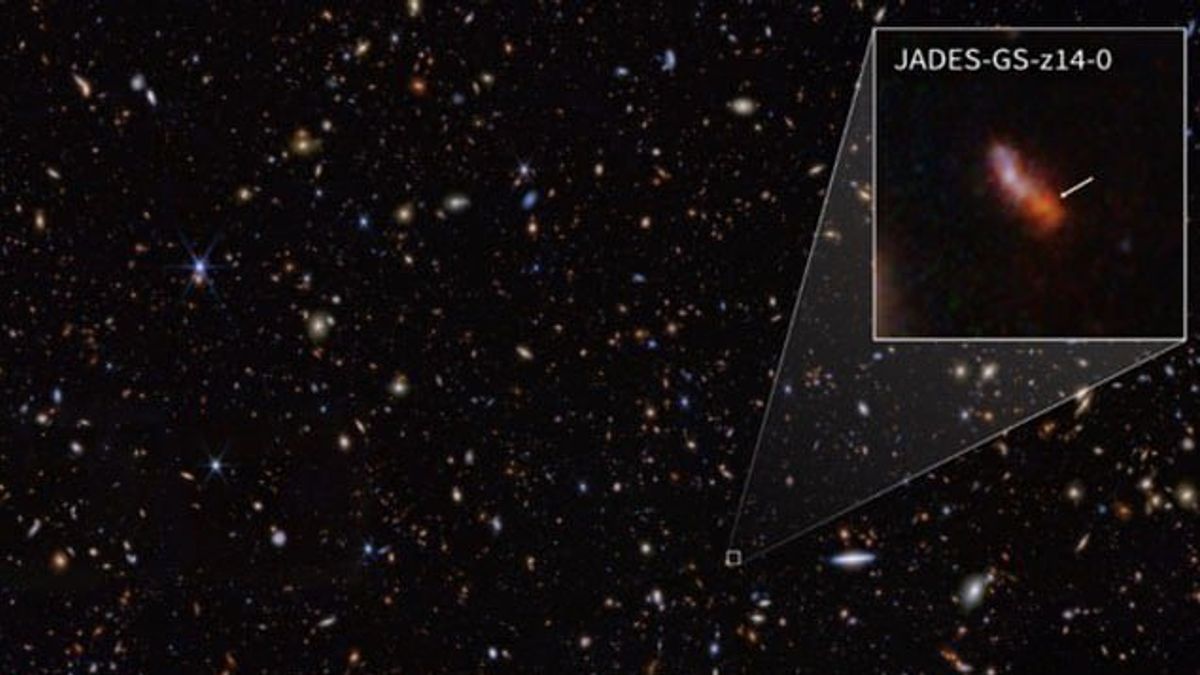JAKARTA - NASA's James Webb telescope has reached a monumental discovery by identifying the furthest galaxy ever observed, named JADES-GS-z14-0. The light from this galaxy has traveled about 13.5 billion years to reach us, meaning this light begins its journey just 300 million years after the Big Bang.
The discovery offers unprecedented insight into the early universe, highlighting the telescope's capabilities worth $10 billion.
Distance and Age: JADES-GS-z14-0 is the furthest galaxy ever discovered so far, with its light traveling about 13.5 billion years to reach Earth. This suggests that this galaxy formed when the universe was only about 300 million years old.
Size: This galaxy has a size of about 1,600 light years. Although its size is large enough for the early stages of the universe, this galaxy is still relatively small compared to our Milky Way, which has a diameter of about 100,000 light-years.
Brightness: This galaxy is well known for its size and luminosity, mainly because of the enormous amount of light produced by its young stars. This characteristic makes JADES-GS-z14-0 extraordinary and significant for astronomers studying the early universe.
SEE ALSO:
The James Webb telescope, which is placed near the second Lagrange point (L2) as far as one million miles from Earth, takes advantage of its sophisticated infrared capabilities to look into the past. By capturing the light that has traveled billions of years, the telescope provides an overview of how galaxies look in their youth.
Infrared observations: The telescope's ability to detect infrared light is essential. As the universe expands, light from distant galaxies is stretched, shifting to the infrared spectrum. The James Webb instrument is designed to capture this switching light with unprecedented clarity.
Chemical Analysis: By breaking light into the colors of its constituents, astronomers can study the chemical composition of distant galaxies. For JADES-GS-z14-0, a strong hydrogen signal was detected, indicating the presence of primordial gas from the early universe.
The discovery of JADES-GS-z14-0 is an important milestone in our understanding of the early universe. The data obtained from these galaxies provide insight into the formation and evolution of the first stars and galaxies. It also opens up the possibility to discover more galaxies like this, which further push the boundaries to what extent we can observe the past.
Extragalactic discoveries: As stated by Brant Robertson, an astronomer at the University of California, Santa Cruz, this discovery is considered the most significant extragalactic discovery with the James Webb Space Telescope to date. This suggests the existence of more hidden treasures in the early universe that this telescope could find.
The exploration of Fajar Kosmis: Over the past two years, James Webb has explored the period of "fajar Badminton", the period in the first few hundred million years after the Big Bang when the first galaxies formed. These observations are critical to understanding how the early universe transitions from a state dominated by gas to one filled with stars and galaxies.
The discovery of JADES-GS-z14-0 by the James Webb Space Telescope is an important milestone in astrophysics. It not only shows the advanced capabilities of this telescope, but also provides invaluable data on the structure and composition of the early universe. As this telescope continues to explore the distant cosmos, we can expect more breakthrough discoveries that will improve our understanding of the origins and evolution of the universe.
The English, Chinese, Japanese, Arabic, and French versions are automatically generated by the AI. So there may still be inaccuracies in translating, please always see Indonesian as our main language. (system supported by DigitalSiber.id)














